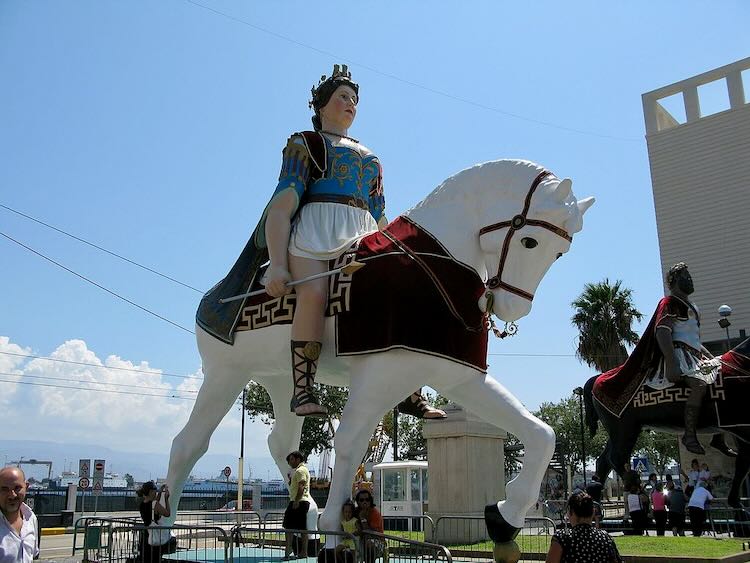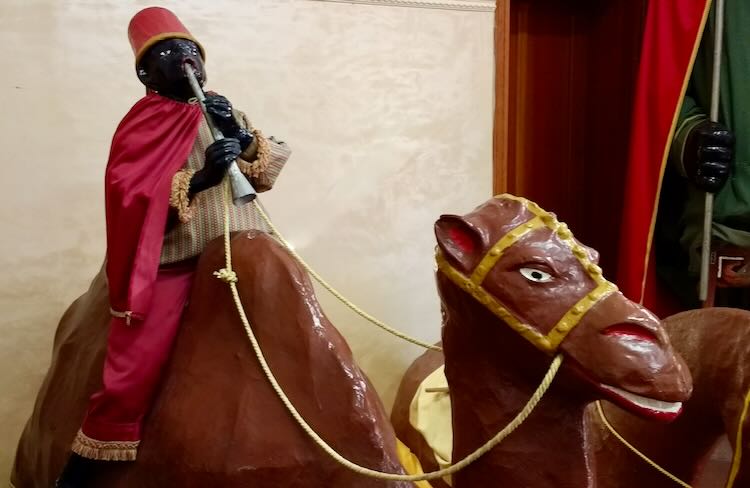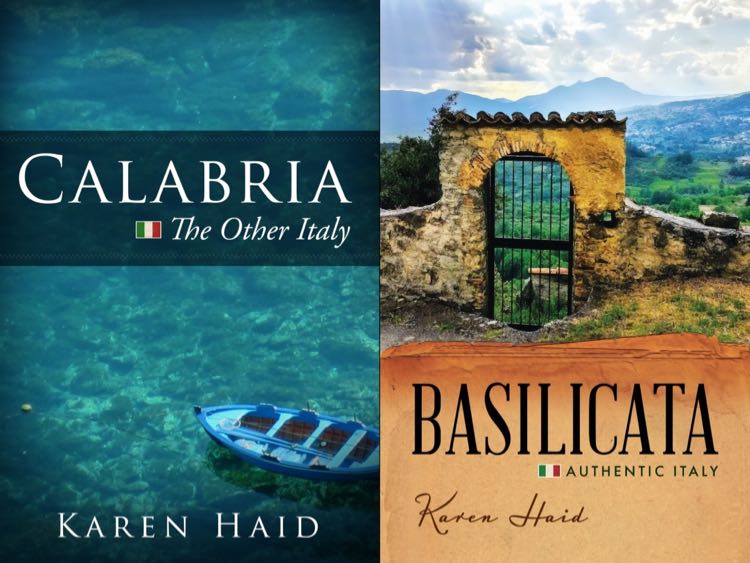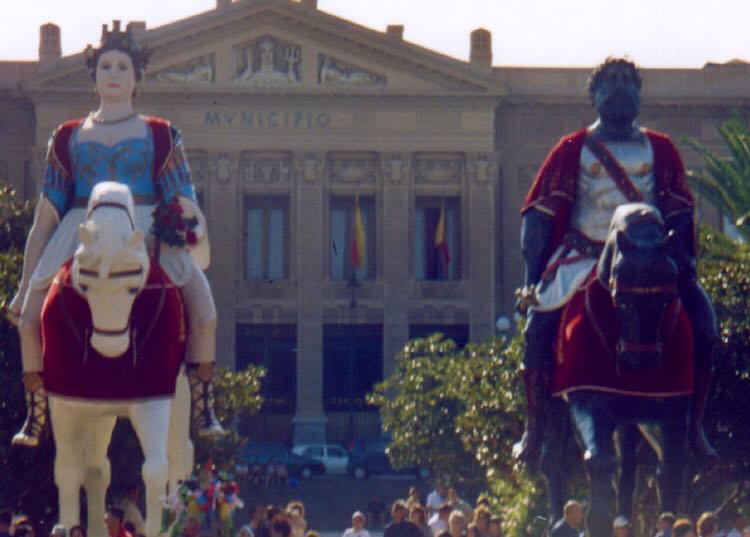While at rest, the exotic figures attract a bold curiosity from even the smallest children. On the move, however, the large, otherworldly puppets not only send the wee ones fleeing for safety, but the towering effigies along with their accompanying ruckus have actually been known to frighten a former king and his entire military entourage into retreat.
I GIGANTI [ee djee-GAHN-tee] – LEGEND
A glimpse of i giganti at a Sicilian or Calabrian festival is a treat for all ages. But who are these folkloric giants – the golden-haired damsel and her dark-skinned suitor – and what are their origins? Just as the evocative figures float and whirl through the streets, their history entwines actual events and colorful myth to create the intriguing tradition that is referred to in local dialects by names ranging from jijante, gehante, gehanti, gihanta, giaganti to pulicenelle and purucineja.
The legend of the giganti is generally thought to originate in Messina, the northeastern Sicilian city that is separated from Calabria in the toe of the mainland by the aptly named Strait of Messina. Some accounts tell of a beautiful peasant girl, others of a local princess, but whatever her social position, the young maiden came from a virtuous, Christian family. Her name was Marta, or Mata in dialect. One day around 970 A.D. during the period of the Saracen invasions, a very tall Arab named Hassass Ibn-Hammar came ashore with his men to pillage the city. Upon seeing the lovely Mata, the prince asked for her hand in marriage. She refused, causing him to plunder all the more.
As a good Catholic, Mata resorted to prayer. Some stories tell of her kidnapping, but whether voluntarily or by force, she eventually capitulated and fell in love with the Muslim prince when he converted to Christianity and gave up his barbaric ways. He subsequently changed his name to Grifo and came to be known as Grifone due to his noteworthy physical stature. (The suffix -one denotes largeness in Italian.)
I GIGANTI – MYTHS AND HISTORY
Another explanation as to the origin of Mata and Grifone can be found in classical mythology. The pair is thought to represent the ancient Greek gods Kronos and Rhea, Messina’s mythological founders.
The historical version of the couple’s roots dates back to 1190 A.D. when Richard the Lionhearted disembarked at Messina on his way to the Holy Land during the Third Crusade. By this time, the Normans had kicked the Arabs out of Sicily, and Tancred had become king by way of a coup that resulted in the imprisonment of Richard’s sister. Messina landed in the middle of the argument when the English king set siege to the city. He is said to have built a castle called Mategrifon, which stood for “ammazza-griffoni,” or “Kill the thieves,” referring to the Arab and Greek invaders. The kings eventually came to an agreement, and over time other defensive fortifications superseded Richard’s Mategrifon on the strategic position overlooking the city.
THE GIANTS – SICILY
The tradition of the giganti is just one example of the wealth of Italy’s historical and folkloric culture, and each locality adds a personal touch. If sheer size were the measure of passion, Messina would certainly win a prize with its colossal giganti reaching a height of over 26 feet! Incredibly, the motivation for the enormous statues arose in the sixteenth century when gigantic bones of a prehistoric animal were found in the rival city of Palermo. The wooden figures commissioned by Messina’s governing body of the time have naturally undergone a number of restorations and modifications over the years, including the completion of the legs in the 1950s that allowed them to be pulled along on wheels.
Often featured at town festivals associated with patron saints, the giganti process through the streets accompanied by folk musicians – and frequently a camel. The beating of the drums in a quick tarantella rhythm inspires the crowd and the dance or Ballo dei Giganti. Even Messina’s monumental U Giganti e a Gialantissa (the giant and the giantess) simulated the trotting of horses before the modernization of the last century.

Mata and Grifone “Giganti” in Messina (courtesy of Jacopo Werther, Wikimedia Creative Commons CC BY-SA 4.0)
THE GIANTS – CALABRIA
Across the Strait of Messina in Calabria, the giganti aren’t as tall, but they more than compensate with enthusiasm. The figures are constructed of papier-mâché and rest on the shoulders of their handlers.

A snake charmer on his camel dance through the streets on the shoulders of their handlers in Seminara, Calabria
Hidden under the giants’ skirts with a face hole to help guide their way, the puppeteers engage in a dance of courtship – the swarthy, mustached Saracen versus the fair, rosy-cheeked girl next door. Fast footwork to the step of the tarantella conducts the couple through turns, inclinations and other gestures that draw them ever nearer and lead to an embrace or kiss to the delight of the crowd.
The ballo is accompanied by the incessant beating of drums that not only requires great stamina from the puppeteers, but has even inspired legends. One popular story dates back to October 1815 and tells of Joachim Murat, Napoleon’s brother-in-law and former King of Naples, who was attempting to retake power by way of Calabria. As Murat and his military retinue approached the small coastal town of Briatico on Capo Vaticano, the piece of land that juts out into the Tyrrhenian Sea, they were accosted by an extraordinary noise coming from the village. What sounded like a garrison of soldiers in battle was actually an assortment of drums and the shouts of the crowd escorting the giganti at a festival. Murat and his men changed direction and disembarked a few miles up the coast at Pizzo, where he was arrested and swiftly executed, foiling the coup attempt and perhaps changing the course of history.
I GIGANTI – TRADITIONS
Calabria and Sicily share the giganti as they share the Strait and histories plagued with foreign incursion and domination. The ballo of Mata and Grifone is commonly viewed as a representation of the struggle between Islam and Catholicism. In festive atmospheres throughout the regions, the conflict is peacefully resolved, the people emerge victoriously, liberty is preserved and everyone has a good time. Long histories and engaging folkloric traditions come together to form part of a rich cultural fabric in which i giganti play an important part, both enlightening and entertaining the generations of today and tomorrow.
Interested in experiencing Southern Italy on a small-group cultural tour? Check out the itineraries of my Calabria Tours and my Basilicata Tour and get in touch!
I originally wrote this article for the Order Sons and Daughters of Italy in America and it appeared in Winter 2015 edition of their Italian America magazine.
Read all about the fascinating Calabrian region in my book Calabria: The Other Italy, described by Publisher’s Weekly as “an intoxicating blend of humor, joy, and reverence for this area in Italy’s deep south,” and explore Calabria’s northern neighbor in my book Basilicata: Authentic Italy, “recommended to readers who appreciate all things Italian” by the Library Journal.
Follow me on social media: Basilicata Facebook page, Calabria: The Other Italy’s Facebook page, Karen’s Instagram and Karen’s Twitter for beautiful pictures and information.
Sign up below to receive the next blog post directly to your email for free.








Comments 8
So much truly quirky history you find to share with your readers! Reminds me a little of Stravinsky’s Petruchska with the Moor & the ballerina. My husband & I are looking forward to our trip with you in September, Karen! Hope all is well with you & that you’re enjoying your time in Italy before your upcoming tour which I believe starts next week! Ciao for now!
Author
Yes, I’m looking forward to the upcoming tour, as well! Interesting Stravinsky comparison – thanks for your thoughts.
Karen-
Great writing. We have been to the “Caves of the Giants” in Sardegna. Have you been ?
We are renovating our house in Calabria.
Daniel
Author
Thanks, I’ve heard of the Bronze age tombs of the giants in Sardegna, but haven’t ever been – definitely interesting archeology to explore. Hope your renovation goes smoothly and you’ll reap the rewards soon!
Even as an adult these massive puppets look frightening to me! But, how fascinating the combination of myth and folklore that swirls behind their historic origins. Wishing you well!
Author
Thanks. Yes, it’s amazing how long such a colorful, folkloric history has survived especially in a world that seems to be changing by the minute.
You so well explain traditions and stories, going into many details but never boring.
Thank you for sharing your research in such an interesting blog.
Author
My pleasure, so glad you enjoy and appreciate it!